Diploma of Nursing: Rheumatic Heart Disease & Indigenous Healthcare
VerifiedAdded on 2023/06/04
|6
|1292
|125
Discussion Board Post
AI Summary
This discussion post addresses Rheumatic Heart Disease (RHD) and its impact on Indigenous Australians, exploring factors like poor housing, sanitation, and limited access to healthcare. It delves into cultural awareness and sensitivity in nursing, emphasizing the importance of respecting diverse cultural values and norms. The discussion also covers the Aboriginal and Torres Strait Islander Act 2005 and the effects of European settlement on Indigenous populations, including healthcare disparities. It highlights the need for Indigenous participation in healthcare planning and delivery, effective communication strategies, and addressing trauma-related communication barriers. The post further emphasizes the role of culturally competent professionals and reshaping personal values to accommodate Indigenous needs, while also identifying culturally unsafe practices in healthcare. Desklib offers numerous resources including past papers and solved assignments for nursing students.
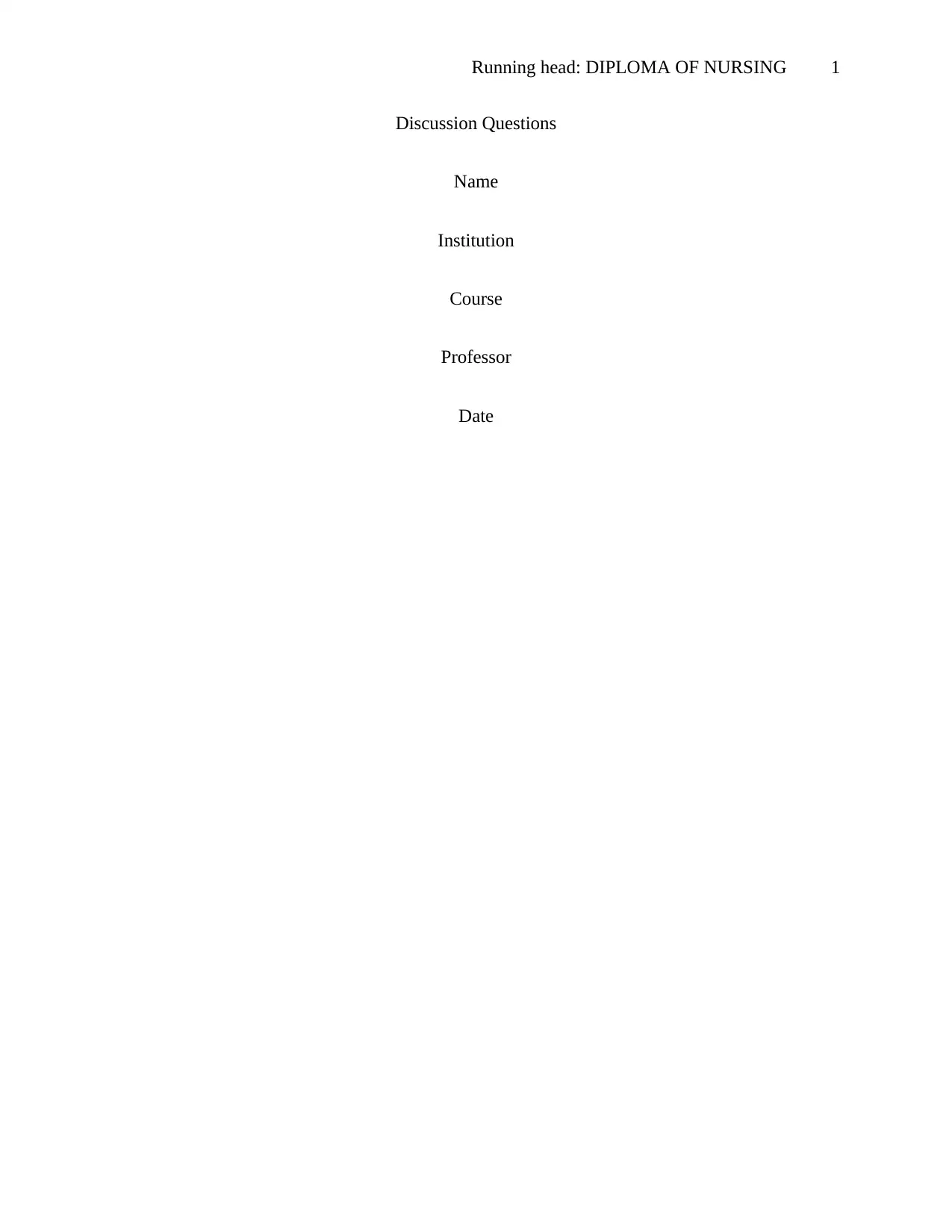
Running head: DIPLOMA OF NURSING 1
Discussion Questions
Name
Institution
Course
Professor
Date
Discussion Questions
Name
Institution
Course
Professor
Date
Paraphrase This Document
Need a fresh take? Get an instant paraphrase of this document with our AI Paraphraser
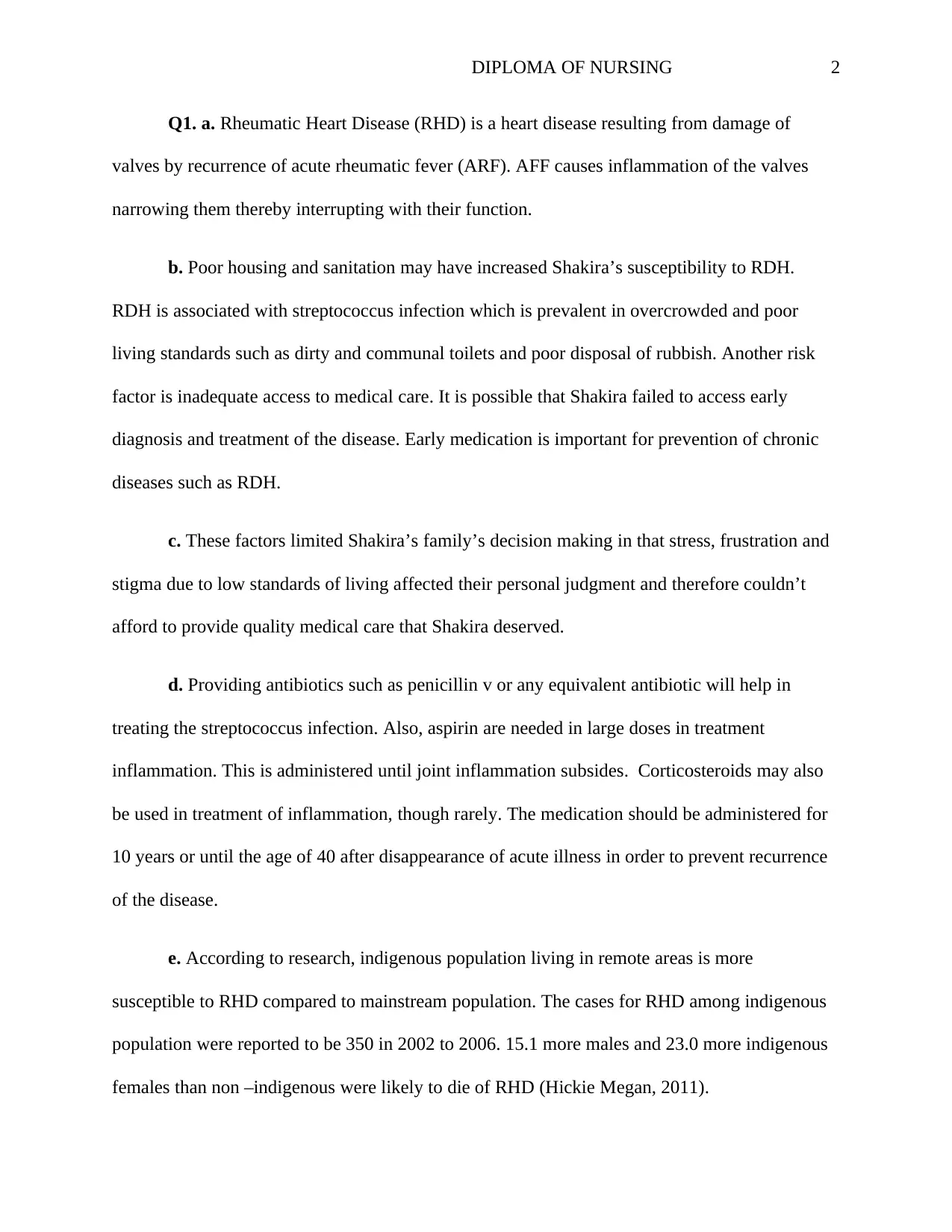
DIPLOMA OF NURSING 2
Q1. a. Rheumatic Heart Disease (RHD) is a heart disease resulting from damage of
valves by recurrence of acute rheumatic fever (ARF). AFF causes inflammation of the valves
narrowing them thereby interrupting with their function.
b. Poor housing and sanitation may have increased Shakira’s susceptibility to RDH.
RDH is associated with streptococcus infection which is prevalent in overcrowded and poor
living standards such as dirty and communal toilets and poor disposal of rubbish. Another risk
factor is inadequate access to medical care. It is possible that Shakira failed to access early
diagnosis and treatment of the disease. Early medication is important for prevention of chronic
diseases such as RDH.
c. These factors limited Shakira’s family’s decision making in that stress, frustration and
stigma due to low standards of living affected their personal judgment and therefore couldn’t
afford to provide quality medical care that Shakira deserved.
d. Providing antibiotics such as penicillin v or any equivalent antibiotic will help in
treating the streptococcus infection. Also, aspirin are needed in large doses in treatment
inflammation. This is administered until joint inflammation subsides. Corticosteroids may also
be used in treatment of inflammation, though rarely. The medication should be administered for
10 years or until the age of 40 after disappearance of acute illness in order to prevent recurrence
of the disease.
e. According to research, indigenous population living in remote areas is more
susceptible to RHD compared to mainstream population. The cases for RHD among indigenous
population were reported to be 350 in 2002 to 2006. 15.1 more males and 23.0 more indigenous
females than non –indigenous were likely to die of RHD (Hickie Megan, 2011).
Q1. a. Rheumatic Heart Disease (RHD) is a heart disease resulting from damage of
valves by recurrence of acute rheumatic fever (ARF). AFF causes inflammation of the valves
narrowing them thereby interrupting with their function.
b. Poor housing and sanitation may have increased Shakira’s susceptibility to RDH.
RDH is associated with streptococcus infection which is prevalent in overcrowded and poor
living standards such as dirty and communal toilets and poor disposal of rubbish. Another risk
factor is inadequate access to medical care. It is possible that Shakira failed to access early
diagnosis and treatment of the disease. Early medication is important for prevention of chronic
diseases such as RDH.
c. These factors limited Shakira’s family’s decision making in that stress, frustration and
stigma due to low standards of living affected their personal judgment and therefore couldn’t
afford to provide quality medical care that Shakira deserved.
d. Providing antibiotics such as penicillin v or any equivalent antibiotic will help in
treating the streptococcus infection. Also, aspirin are needed in large doses in treatment
inflammation. This is administered until joint inflammation subsides. Corticosteroids may also
be used in treatment of inflammation, though rarely. The medication should be administered for
10 years or until the age of 40 after disappearance of acute illness in order to prevent recurrence
of the disease.
e. According to research, indigenous population living in remote areas is more
susceptible to RHD compared to mainstream population. The cases for RHD among indigenous
population were reported to be 350 in 2002 to 2006. 15.1 more males and 23.0 more indigenous
females than non –indigenous were likely to die of RHD (Hickie Megan, 2011).
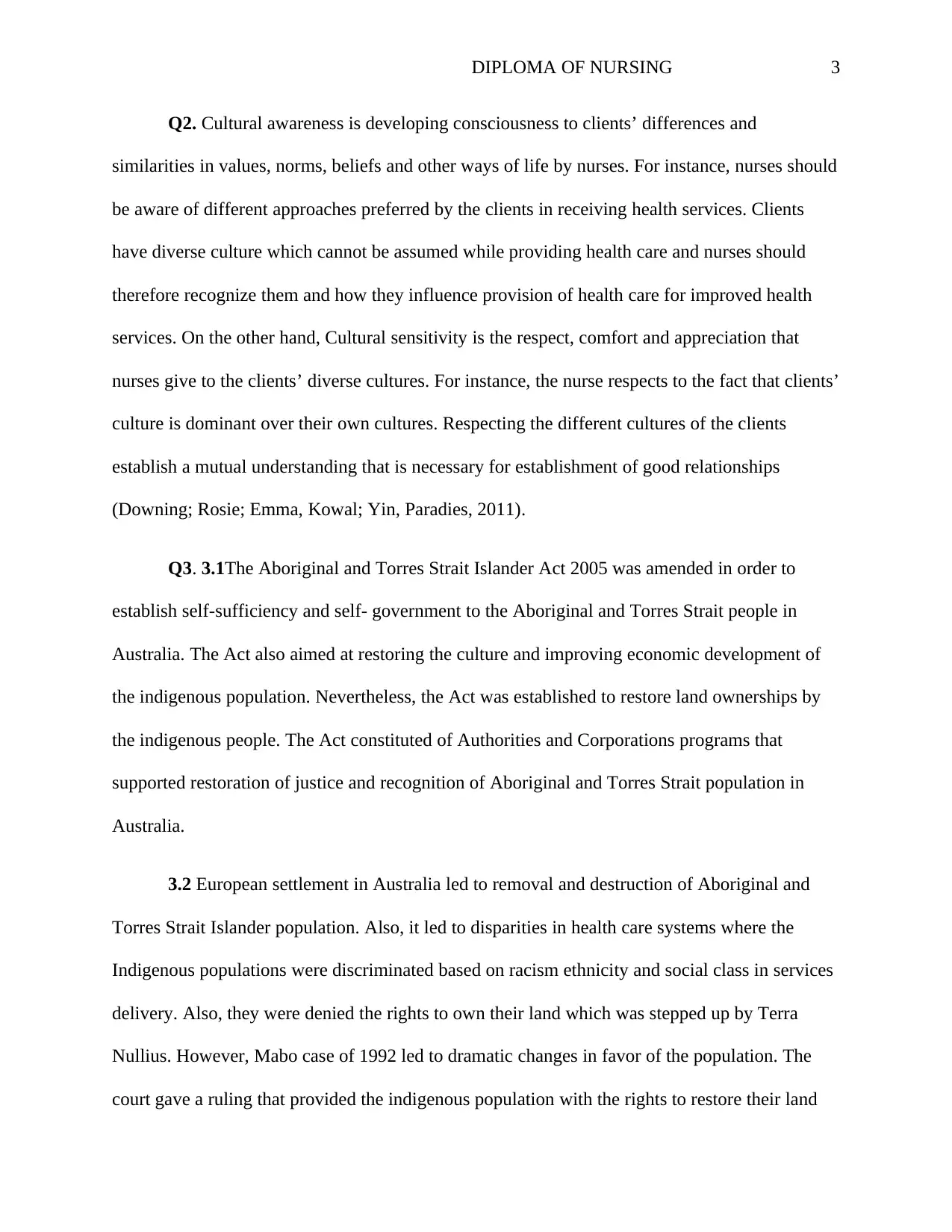
DIPLOMA OF NURSING 3
Q2. Cultural awareness is developing consciousness to clients’ differences and
similarities in values, norms, beliefs and other ways of life by nurses. For instance, nurses should
be aware of different approaches preferred by the clients in receiving health services. Clients
have diverse culture which cannot be assumed while providing health care and nurses should
therefore recognize them and how they influence provision of health care for improved health
services. On the other hand, Cultural sensitivity is the respect, comfort and appreciation that
nurses give to the clients’ diverse cultures. For instance, the nurse respects to the fact that clients’
culture is dominant over their own cultures. Respecting the different cultures of the clients
establish a mutual understanding that is necessary for establishment of good relationships
(Downing; Rosie; Emma, Kowal; Yin, Paradies, 2011).
Q3. 3.1The Aboriginal and Torres Strait Islander Act 2005 was amended in order to
establish self-sufficiency and self- government to the Aboriginal and Torres Strait people in
Australia. The Act also aimed at restoring the culture and improving economic development of
the indigenous population. Nevertheless, the Act was established to restore land ownerships by
the indigenous people. The Act constituted of Authorities and Corporations programs that
supported restoration of justice and recognition of Aboriginal and Torres Strait population in
Australia.
3.2 European settlement in Australia led to removal and destruction of Aboriginal and
Torres Strait Islander population. Also, it led to disparities in health care systems where the
Indigenous populations were discriminated based on racism ethnicity and social class in services
delivery. Also, they were denied the rights to own their land which was stepped up by Terra
Nullius. However, Mabo case of 1992 led to dramatic changes in favor of the population. The
court gave a ruling that provided the indigenous population with the rights to restore their land
Q2. Cultural awareness is developing consciousness to clients’ differences and
similarities in values, norms, beliefs and other ways of life by nurses. For instance, nurses should
be aware of different approaches preferred by the clients in receiving health services. Clients
have diverse culture which cannot be assumed while providing health care and nurses should
therefore recognize them and how they influence provision of health care for improved health
services. On the other hand, Cultural sensitivity is the respect, comfort and appreciation that
nurses give to the clients’ diverse cultures. For instance, the nurse respects to the fact that clients’
culture is dominant over their own cultures. Respecting the different cultures of the clients
establish a mutual understanding that is necessary for establishment of good relationships
(Downing; Rosie; Emma, Kowal; Yin, Paradies, 2011).
Q3. 3.1The Aboriginal and Torres Strait Islander Act 2005 was amended in order to
establish self-sufficiency and self- government to the Aboriginal and Torres Strait people in
Australia. The Act also aimed at restoring the culture and improving economic development of
the indigenous population. Nevertheless, the Act was established to restore land ownerships by
the indigenous people. The Act constituted of Authorities and Corporations programs that
supported restoration of justice and recognition of Aboriginal and Torres Strait population in
Australia.
3.2 European settlement in Australia led to removal and destruction of Aboriginal and
Torres Strait Islander population. Also, it led to disparities in health care systems where the
Indigenous populations were discriminated based on racism ethnicity and social class in services
delivery. Also, they were denied the rights to own their land which was stepped up by Terra
Nullius. However, Mabo case of 1992 led to dramatic changes in favor of the population. The
court gave a ruling that provided the indigenous population with the rights to restore their land
⊘ This is a preview!⊘
Do you want full access?
Subscribe today to unlock all pages.

Trusted by 1+ million students worldwide
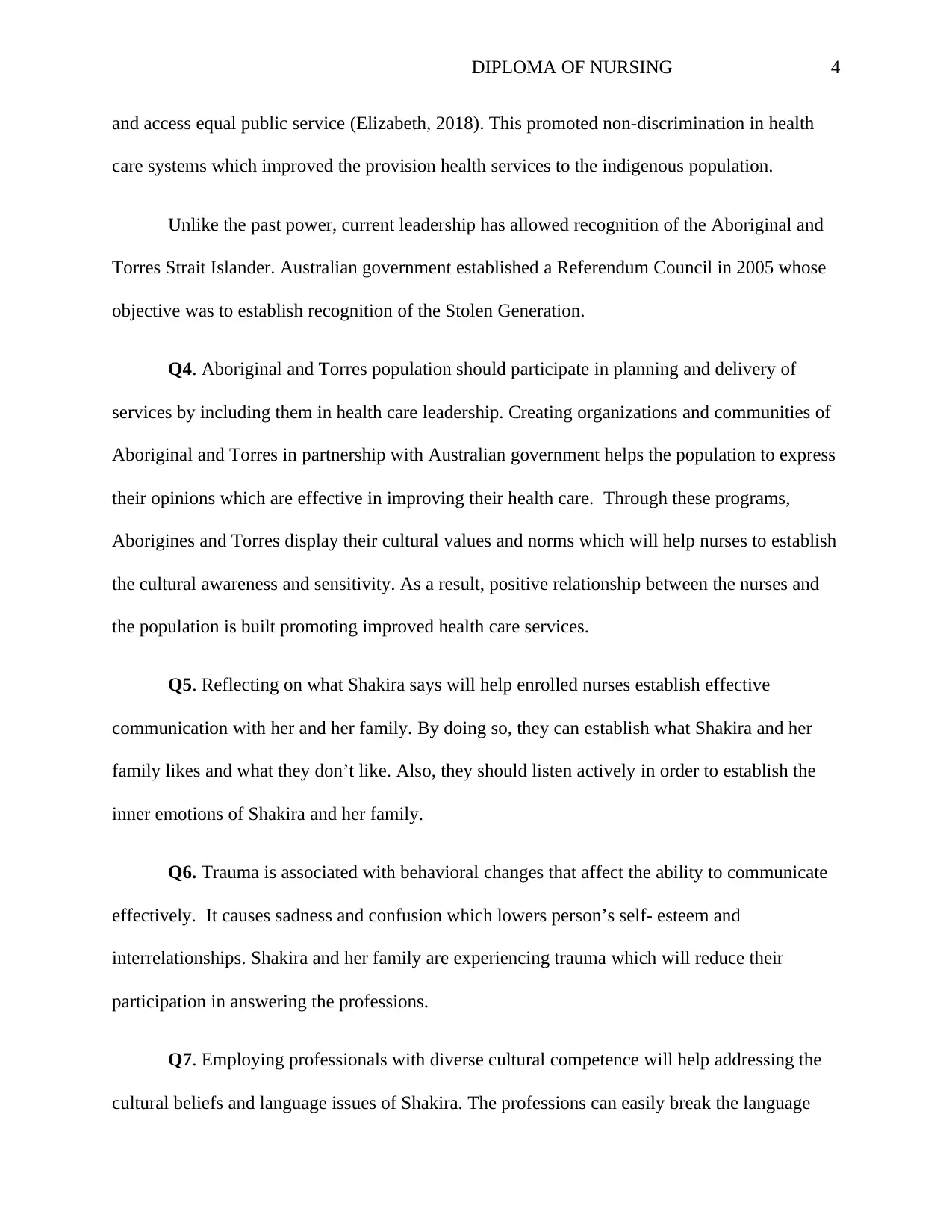
DIPLOMA OF NURSING 4
and access equal public service (Elizabeth, 2018). This promoted non-discrimination in health
care systems which improved the provision health services to the indigenous population.
Unlike the past power, current leadership has allowed recognition of the Aboriginal and
Torres Strait Islander. Australian government established a Referendum Council in 2005 whose
objective was to establish recognition of the Stolen Generation.
Q4. Aboriginal and Torres population should participate in planning and delivery of
services by including them in health care leadership. Creating organizations and communities of
Aboriginal and Torres in partnership with Australian government helps the population to express
their opinions which are effective in improving their health care. Through these programs,
Aborigines and Torres display their cultural values and norms which will help nurses to establish
the cultural awareness and sensitivity. As a result, positive relationship between the nurses and
the population is built promoting improved health care services.
Q5. Reflecting on what Shakira says will help enrolled nurses establish effective
communication with her and her family. By doing so, they can establish what Shakira and her
family likes and what they don’t like. Also, they should listen actively in order to establish the
inner emotions of Shakira and her family.
Q6. Trauma is associated with behavioral changes that affect the ability to communicate
effectively. It causes sadness and confusion which lowers person’s self- esteem and
interrelationships. Shakira and her family are experiencing trauma which will reduce their
participation in answering the professions.
Q7. Employing professionals with diverse cultural competence will help addressing the
cultural beliefs and language issues of Shakira. The professions can easily break the language
and access equal public service (Elizabeth, 2018). This promoted non-discrimination in health
care systems which improved the provision health services to the indigenous population.
Unlike the past power, current leadership has allowed recognition of the Aboriginal and
Torres Strait Islander. Australian government established a Referendum Council in 2005 whose
objective was to establish recognition of the Stolen Generation.
Q4. Aboriginal and Torres population should participate in planning and delivery of
services by including them in health care leadership. Creating organizations and communities of
Aboriginal and Torres in partnership with Australian government helps the population to express
their opinions which are effective in improving their health care. Through these programs,
Aborigines and Torres display their cultural values and norms which will help nurses to establish
the cultural awareness and sensitivity. As a result, positive relationship between the nurses and
the population is built promoting improved health care services.
Q5. Reflecting on what Shakira says will help enrolled nurses establish effective
communication with her and her family. By doing so, they can establish what Shakira and her
family likes and what they don’t like. Also, they should listen actively in order to establish the
inner emotions of Shakira and her family.
Q6. Trauma is associated with behavioral changes that affect the ability to communicate
effectively. It causes sadness and confusion which lowers person’s self- esteem and
interrelationships. Shakira and her family are experiencing trauma which will reduce their
participation in answering the professions.
Q7. Employing professionals with diverse cultural competence will help addressing the
cultural beliefs and language issues of Shakira. The professions can easily break the language
Paraphrase This Document
Need a fresh take? Get an instant paraphrase of this document with our AI Paraphraser
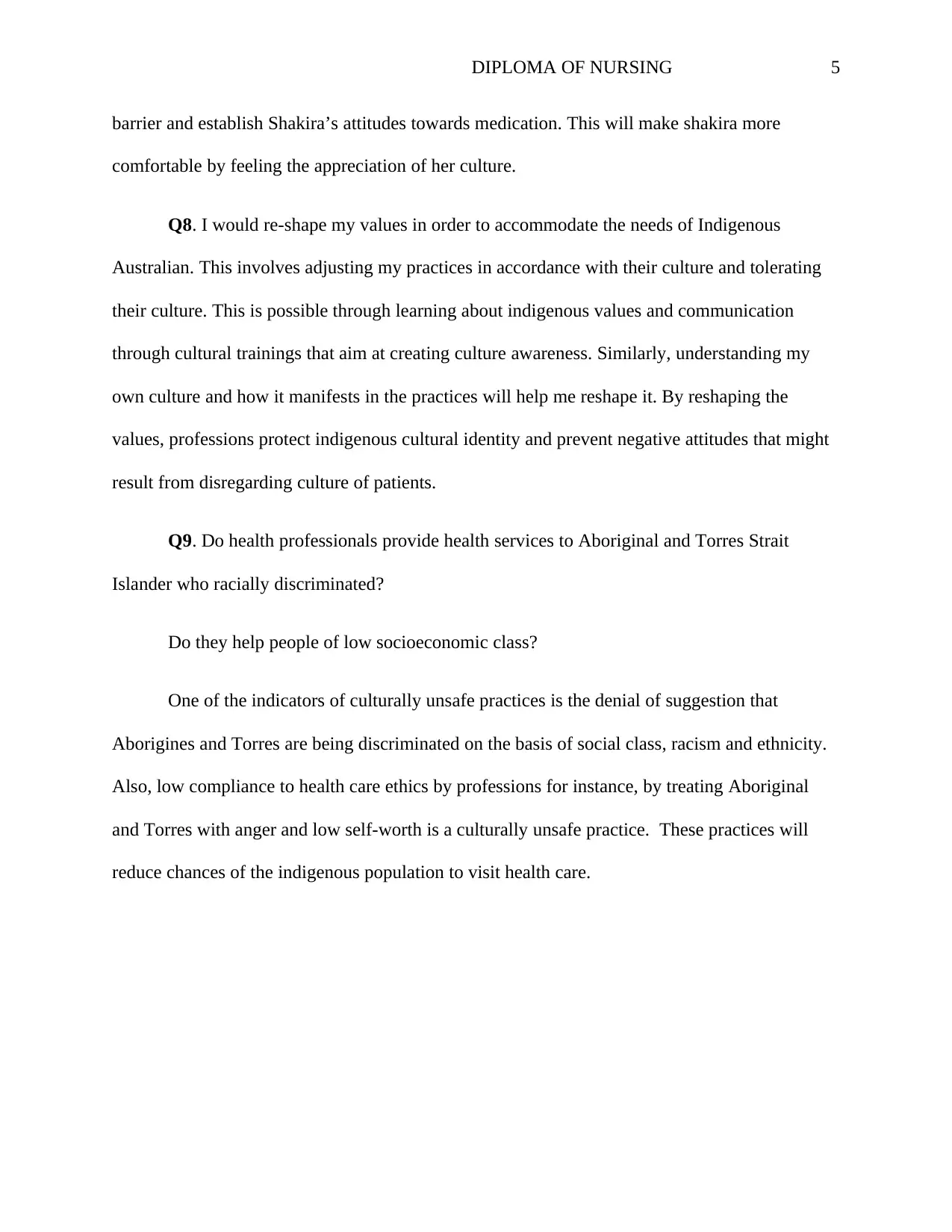
DIPLOMA OF NURSING 5
barrier and establish Shakira’s attitudes towards medication. This will make shakira more
comfortable by feeling the appreciation of her culture.
Q8. I would re-shape my values in order to accommodate the needs of Indigenous
Australian. This involves adjusting my practices in accordance with their culture and tolerating
their culture. This is possible through learning about indigenous values and communication
through cultural trainings that aim at creating culture awareness. Similarly, understanding my
own culture and how it manifests in the practices will help me reshape it. By reshaping the
values, professions protect indigenous cultural identity and prevent negative attitudes that might
result from disregarding culture of patients.
Q9. Do health professionals provide health services to Aboriginal and Torres Strait
Islander who racially discriminated?
Do they help people of low socioeconomic class?
One of the indicators of culturally unsafe practices is the denial of suggestion that
Aborigines and Torres are being discriminated on the basis of social class, racism and ethnicity.
Also, low compliance to health care ethics by professions for instance, by treating Aboriginal
and Torres with anger and low self-worth is a culturally unsafe practice. These practices will
reduce chances of the indigenous population to visit health care.
barrier and establish Shakira’s attitudes towards medication. This will make shakira more
comfortable by feeling the appreciation of her culture.
Q8. I would re-shape my values in order to accommodate the needs of Indigenous
Australian. This involves adjusting my practices in accordance with their culture and tolerating
their culture. This is possible through learning about indigenous values and communication
through cultural trainings that aim at creating culture awareness. Similarly, understanding my
own culture and how it manifests in the practices will help me reshape it. By reshaping the
values, professions protect indigenous cultural identity and prevent negative attitudes that might
result from disregarding culture of patients.
Q9. Do health professionals provide health services to Aboriginal and Torres Strait
Islander who racially discriminated?
Do they help people of low socioeconomic class?
One of the indicators of culturally unsafe practices is the denial of suggestion that
Aborigines and Torres are being discriminated on the basis of social class, racism and ethnicity.
Also, low compliance to health care ethics by professions for instance, by treating Aboriginal
and Torres with anger and low self-worth is a culturally unsafe practice. These practices will
reduce chances of the indigenous population to visit health care.
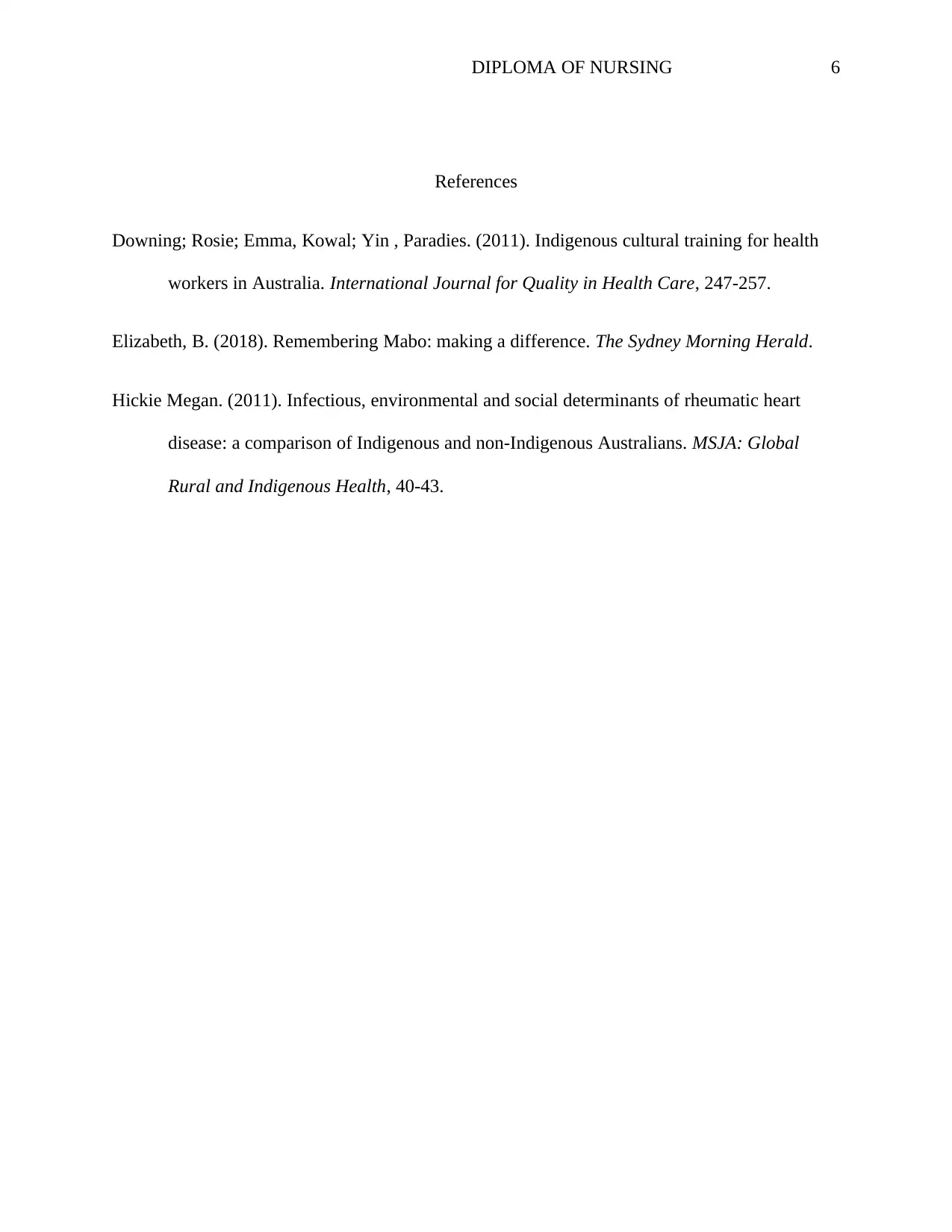
DIPLOMA OF NURSING 6
References
Downing; Rosie; Emma, Kowal; Yin , Paradies. (2011). Indigenous cultural training for health
workers in Australia. International Journal for Quality in Health Care, 247-257.
Elizabeth, B. (2018). Remembering Mabo: making a difference. The Sydney Morning Herald.
Hickie Megan. (2011). Infectious, environmental and social determinants of rheumatic heart
disease: a comparison of Indigenous and non-Indigenous Australians. MSJA: Global
Rural and Indigenous Health, 40-43.
References
Downing; Rosie; Emma, Kowal; Yin , Paradies. (2011). Indigenous cultural training for health
workers in Australia. International Journal for Quality in Health Care, 247-257.
Elizabeth, B. (2018). Remembering Mabo: making a difference. The Sydney Morning Herald.
Hickie Megan. (2011). Infectious, environmental and social determinants of rheumatic heart
disease: a comparison of Indigenous and non-Indigenous Australians. MSJA: Global
Rural and Indigenous Health, 40-43.
⊘ This is a preview!⊘
Do you want full access?
Subscribe today to unlock all pages.

Trusted by 1+ million students worldwide
1 out of 6
Related Documents
Your All-in-One AI-Powered Toolkit for Academic Success.
+13062052269
info@desklib.com
Available 24*7 on WhatsApp / Email
![[object Object]](/_next/static/media/star-bottom.7253800d.svg)
Unlock your academic potential
Copyright © 2020–2025 A2Z Services. All Rights Reserved. Developed and managed by ZUCOL.





